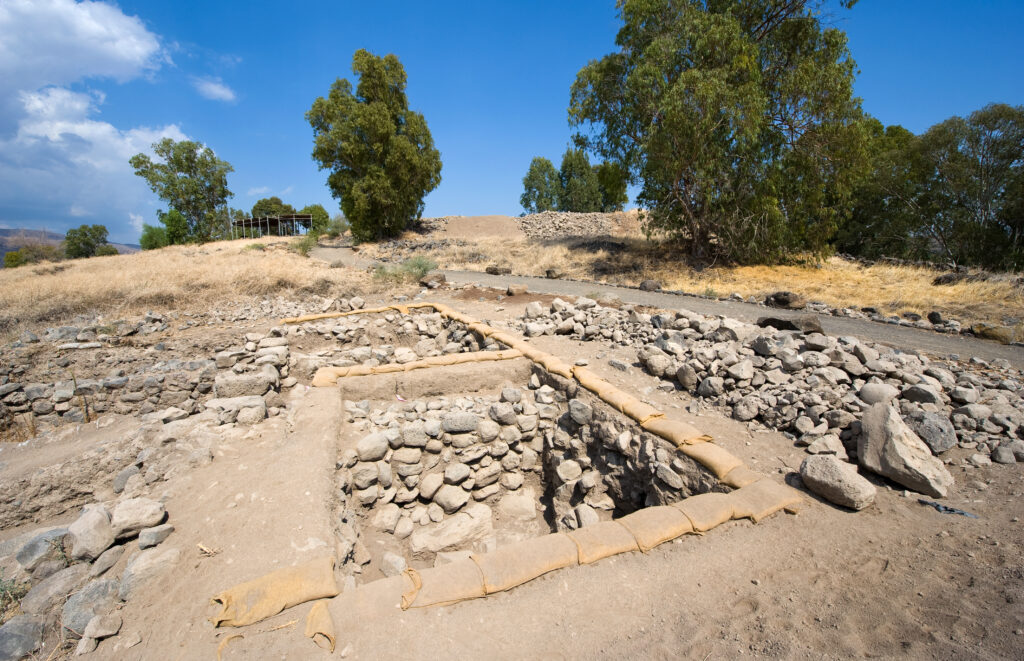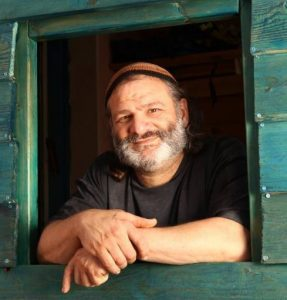Archaeologists excavating el-Araj, identified with ancient Bethsaida on the northern shore of the Sea of Galilee, have uncovered 1,700-year-old fox footprints preserved in the plaster of a Byzantine-era church believed to be the Church of the Apostles. The basilica, built in the 4th century and rebuilt in the 5th, has long been linked to Bethsaida-Julias — the fishing village known from the Gospels as the hometown of Peter, Andrew, and Philip — and the find evokes the desolation foretold by Jeremiah and Micah, yet Jewish tradition ties those prophecies to a future of rebirth and restoration, reflected in Israel’s modern revival.
Haaretz reported that the fox tracks were discovered during the current excavation season when the angle of sunlight exposed the faint impressions on a freshly cleaned wall. Initial assumptions pointed to a cat, but measurements confirmed the prints belonged to a young red fox. Researchers believe the animal entered the site at night while the plaster was still drying, stepping silently across the newly built wall as the builders slept.
“It’s a moment frozen in time,” said excavation director Dr. Mordechai Aviam of Kinneret Academic College. “You can imagine the workers leaving for the day, the night falling, and a fox slipping in to explore. It is a small detail that somehow connects us very closely to the life of the site.”
The wall on which the prints appear forms part of the Church of the Apostles complex, which Byzantine pilgrims believed stood over the home of the apostle Peter. Excavations beneath the basilica have exposed earlier domestic structures from the Roman and first-century period, aligning historically and geographically with the New Testament descriptions of Bethsaida.
A mosaic inscription discovered in the basilica refers to Peter as the “chief and commander of the heavenly apostles,” further anchoring the Christian memory tied to the site.
El-Araj has been under active excavation since 2016. Findings have included remains of a Roman bathhouse, numerous fishing weights, imported sigillata pottery, and an unusually large number of coins, supporting both the village’s fishing economy and its later status as Julias, a small Roman city.

The ongoing discovery strengthens the archaeological case for el-Araj as Bethsaida, after decades of debate regarding its precise location.
The article’s researchers highlighted a biblical resonance in the fox’s presence. In Lamentations 5:18, the prophet Jeremiah laments the desolation of Jerusalem:
“For the mountain of Zion, which is desolate, the foxes walk upon it.”
The fox prints at Bethsaida do not indicate ruin, they noted, but rather continuity—a reminder that even as human history rises, falls, and is remembered again, life continues quietly in the background.
Indeed, Jewish tradition emphasizes that the verse in Lamentations, while describing foxes as a sign of desolation, is a harbinger of hope. This precise scenario was discussed in the Talmud (Makkot 24b). Rabban Gamliel, Rabbi Elazar ben Azaria, Rabbi Joshua, and Rabbi Akiva went up to Jerusalem.
When they reached the Temple Mount, they saw a fox emerging from the place of the Holy of Holies.
The others started weeping, but Rabbi Akiva laughed. Rabbi Akiva asked the rabbis why they cried, and they explained that seeing a wild animal in such a holy place, a place forbidden to unfit men, was distressing. Rabbi Akiva noted that this was precisely the reason he laughed. He explained that the fact that the prophecy of Uriah, as related by the Prophet Micah, had come to pass was proof that the prophecy of Zechariah would also come to pass.
The Prophet Micah described the destruction of Jerusalem.
Assuredly, because of you Tzion shall be plowed as a field, And Yerushalayim shall become heaps of ruins, And the Har Habayit A shrine in the woods. Micah 3:12
As Rabbi Akiva noted, the Prophet Zechariah described the return of Jerusalem to its days of glory:
Thus said the lord of Hosts: There shall yet be old men and women in the squares of Yerushalayim, each with a staff in hand because of their great age. And the squares of the city shall be crowded with boys and girls playing in the squares. Zechariah 4-5
The tiny fox that visited Bethsaida 1,700 years ago was a sign of desolation, but just as Rabbi Akiva welcomed the fox as a harbinger of rebirth, Bethsaida has risen from the ashes. Bethsaida was abandoned at several points in its history, most notably in the 3rd century, after serving as a Roman city, and again after the Muslim conquest of the Holy Land, following a period of decline. It experienced destruction during the Roman-Jewish war in 67 CE, but was rebuilt and inhabited by both Jews and Gentiles until it was abandoned in the 3rd century. A major earthquake in 363 CE destroyed the village, which was rebuilt and eventually abandoned.
But the Christian site is experiencing a rebirth. Christian pilgrims visiting Israel typically include Bethsaida as a stop on a larger itinerary that focuses on Jerusalem and the Sea of Galilee. Before the pandemic, Israel welcomed an estimated 2.5 million Christian pilgrims annually.
Indeed, Israel is a haven for devout Christians in the Middle East. This is most powerfully illustrated in Bethlehem. For centuries, pilgrims have journeyed to Bethlehem to walk where Jesus walked, to pray in ancient churches, and to celebrate Christmas in the city of his birth. But in recent years, the Christmas celebrations that once filled Manger Square have fallen silent. The traditional festivities that drew thousands of Christian tourists have been canceled for multiple years in a row, leaving the birthplace of Christianity eerily quiet during what should be its most vibrant season.

The decline tells a troubling story. Bethlehem, administered by the Palestinian Authority since 1995, has seen its Christian population plummet from 85% to less than 10% today. Christmas celebrations in Manger Square were canceled in 2023 and 2024, officially due to the war with Hamas, but the city’s Christian decline began long before. The Church of the Nativity, one of Christianity’s holiest sites, sits in a city where Christians increasingly feel unwelcome and unsafe. Tourism revenue has collapsed, not just from regional conflict, but from a decades-long pattern of deterioration under Palestinian Authority governance.
The contrast with Israeli-controlled areas is stark. Israel maintains strict laws protecting religious freedom and access to holy sites for all faiths. The 1967 Protection of Holy Places Law guarantees that “the Holy Places shall be protected from desecration and any other violation and from anything likely to violate the freedom of access of the members of the different religions to the places sacred to them.” Christians freely celebrate Easter at the Church of the Holy Sepulchre in Jerusalem’s Old City every year. The Garden of Gethsemane, the Mount of Olives, and countless other Christian sites under Israeli jurisdiction welcome millions of pilgrims annually without restriction.
The Ministry of Tourism actively promotes Christian pilgrimage routes and maintains infrastructure supporting religious tourism. Meanwhile, tourism to Palestinian Authority-controlled areas has steadily declined even in years without major conflict.
Israel’s protection extends beyond access to physical preservation. The Israeli Antiquities Authority works to preserve and restore Christian sites, recognizing their historical and religious significance. When renovations were needed at the Church of the Holy Sepulchre, Israeli authorities facilitated the work while ensuring continued access for worshippers. This stands in contrast to reports of Christian properties and cemeteries damaged or encroached upon in Palestinian Authority areas, often without consequences for perpetrators.
The Sages taught that Jerusalem would be a gathering place for all nations. The prophet Isaiah declared: “My House shall be a house of prayer for all peoples” (Isaiah 56:7). This vision finds expression in Israeli law and practice, where Muslims pray at the Al-Aqsa Mosque, Jews pray at the Western Wall, and Christians worship at dozens of churches and holy sites throughout Jerusalem and the Galilee.
This protection has practical consequences. The Christian community in Israel proper has grown, not shrunk. Israeli Christians serve in government, operate successful businesses, and practice their faith openly. In Nazareth, Haifa, and Jerusalem, churches thrive and Christian holidays are publicly celebrated. The same cannot be said for Bethlehem, Beit Jala, and other historically Christian towns now under Palestinian Authority control, where the exodus continues year after year.
The cancellation of Christmas in Bethlehem represents more than a missed celebration. It symbolizes the failure of the Palestinian Authority’s governance to protect and nurture the Christian communities under its jurisdiction. While the PA blames external circumstances, the pattern predates current conflicts. Christian emigration, property disputes, and the marginalization of Christian voices in Palestinian society have created an environment where the birthplace of Christianity can no longer celebrate its most important holiday.




